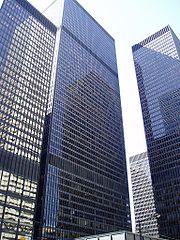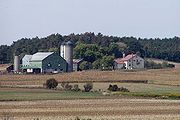
Economy of Ontario
Encyclopedia

Ontario
Ontario is a province of Canada, located in east-central Canada. It is Canada's most populous province and second largest in total area. It is home to the nation's most populous city, Toronto, and the nation's capital, Ottawa....
is the largest economy in Canada
Canada
Canada is a North American country consisting of ten provinces and three territories. Located in the northern part of the continent, it extends from the Atlantic Ocean in the east to the Pacific Ocean in the west, and northward into the Arctic Ocean...
, its GDP being nearly twice that of neighbouring Quebec
Quebec
Quebec or is a province in east-central Canada. It is the only Canadian province with a predominantly French-speaking population and the only one whose sole official language is French at the provincial level....
, the second largest economy. The Ontarian economy is highly influenced, and run by the service sector, though manufacturing
Manufacturing
Manufacturing is the use of machines, tools and labor to produce goods for use or sale. The term may refer to a range of human activity, from handicraft to high tech, but is most commonly applied to industrial production, in which raw materials are transformed into finished goods on a large scale...
also plays an important role.
Ontario is the most populous province of Canada, with a population of about 13 million permanent residents. It is Canada's leading manufacturing province accounting for 52% of the national manufacturing shipments in 2004.
Inflation is slowly reducing in Ontario, it was 2.2% in 2005, and is forecast to be 2.1% in 2006, and 1.8% in 2007. Ontario has an unemployment rate of about 8.5%, slightly higher than the employment rate of Canada as a whole.
Ontario's main exports are motor vehicles parts and accessories (40.4%), Machinery and mechanical appliances (10.8%), electrical machinery & equipment (5.6%) and plastic
Plastic
A plastic material is any of a wide range of synthetic or semi-synthetic organic solids used in the manufacture of industrial products. Plastics are typically polymers of high molecular mass, and may contain other substances to improve performance and/or reduce production costs...
(4.1%).
Ontario's main imports are motor vehicles parts and accessories (22.3%), machinery and mechanical appliances (17.7%), electrical machinery and equipment (10.8%), plastic (4.2%) and scientific, professional and photo equipment (3.6%).
History
In the 19th century, Ontario was mostly unexplored and the amount of natural resources within the province was yet to be recognized, though it was thought of to be very narrow in terms of economic prosperity. Vast amount of land in the province was forest, at the time, the demand for lumber was enormous as wood was needed for heating and building ships, houses, furniture and railways. During the Napoleonic wars, Britain was cut off from its wood supply from the Baltic SeaBaltic Sea
The Baltic Sea is a brackish mediterranean sea located in Northern Europe, from 53°N to 66°N latitude and from 20°E to 26°E longitude. It is bounded by the Scandinavian Peninsula, the mainland of Europe, and the Danish islands. It drains into the Kattegat by way of the Øresund, the Great Belt and...
and was in desperate need for wood. Since 1893, however, this has been renewed.
Agriculture and its economic income

Statistics Canada
Statistics Canada is the Canadian federal government agency commissioned with producing statistics to help better understand Canada, its population, resources, economy, society, and culture. Its headquarters is in Ottawa....
indicates that the farm population in 2001 was 186,085 which is a steep −15.9% decline from 1991's 221,230 farm population. Though urban farm population isn't dropping as fast as the rural, urban farm population dropped by 10%, compared to the rural's −16%.
The 2001 Census of Agriculture indicates that the number of farms has declined sharply between 1996 and 2001, continuing a long-term trend.The 2001 Census of Agriculture counted 59,728 farms in Ontario
Ontario
Ontario is a province of Canada, located in east-central Canada. It is Canada's most populous province and second largest in total area. It is home to the nation's most populous city, Toronto, and the nation's capital, Ottawa....
that's an 11.5% decline since 1996, which is higher than the decline of 10.7% national average.
Even though farms are rapidly reducing in Ontario, Ontario still possesses the highest number of farms in comparison to the provinces and territories, with roughly 59,728. Alberta
Alberta
Alberta is a province of Canada. It had an estimated population of 3.7 million in 2010 making it the most populous of Canada's three prairie provinces...
came second with 53,652, and Newfoundland & Labrador had the fewest with 643 farms. Ontario’s farms nationwide have declined slightly during the past two decades. In 1981, Ontario accounted for 26% of the national total. By 2001, it had declined to 24%.
Although, the number of farms in Ontario is decreasing, the size of farms are increasing. The average Ontario farm size was 226 acre (0.91459036 km²) in 2001, up 9.7% from 1996. Since 1981, the average farm size has increased by 24.9% from 181 acre (0.73248166 km²).
Ontario’s total farm area has declined 2.7% since 1996 to 13,507,357 acres (54,662 km²) in 2001. However, cropland increased 3.2% to just over 9 million acres (36,000 km²), the highest level since 1941. Eastern Ontario
Eastern Ontario
Eastern Ontario is a subregion of Southern Ontario in the Canadian province of Ontario which lies in a wedge-shaped area between the Ottawa River and St. Lawrence River...
led the increase with a gain of 9.2% in cropland.
Energy
The Green Energy and Green Economy Act, 2009 (GEGEA), takes a two-pronged approach to creating a renewable-energy economy. The first is to bring more renewable energy sourcesRenewable resource
A renewable resource is a natural resource with the ability of being replaced through biological or other natural processes and replenished with the passage of time...
to the province and the second is the creation of more energy efficiency
Efficient energy use
Efficient energy use, sometimes simply called energy efficiency, is the goal of efforts to reduce the amount of energy required to provide products and services. For example, insulating a home allows a building to use less heating and cooling energy to achieve and maintain a comfortable temperature...
measures to help conserve energy
Energy conservation
Energy conservation refers to efforts made to reduce energy consumption. Energy conservation can be achieved through increased efficient energy use, in conjunction with decreased energy consumption and/or reduced consumption from conventional energy sources...
. The bill would also appoint a Renewable Energy Facilitator to provide "one-window" assistance and support to project developers in order to facilitate project approvals. The approvals process for transmission projects would also be streamlined and for the first time in Ontario, the bill would enact standards for renewable energy projects. Homeowners would have access to incentives to develop small-scale renewables such as low- or no-interest loan
Loan
A loan is a type of debt. Like all debt instruments, a loan entails the redistribution of financial assets over time, between the lender and the borrower....
s to finance the capital cost of renewable energy generating facilities like solar panels. Solar panels are also manufactured in Ontario.
See also
- Economy of TorontoEconomy of TorontoThe economy of Toronto plays a vital role in Canada's economy and that of the world. Toronto is a commercial, distribution, financial and industrial centre. It is the banking and stock exchange centre of Canada, and is the country's primary wholesale and distribution point. Ontario's wealth of raw...
- Great Lakes MegalopolisGreat Lakes MegalopolisThe Great Lakes Megalopolis consists of the group of North American metropolitan areas which surround the Great Lakes region mainly within the Midwestern United States, the Southern Ontario area of Canada, along with large parts of Pennsylvania, New York, and Quebec...

